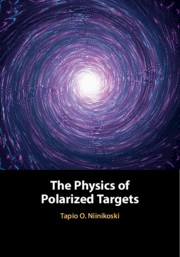Book contents
- The Physics of Polarized Targets
- The Physics of Polarized Targets
- Copyright page
- Dedication
- Contents
- Preface
- Acknowledgements
- 1 Introduction to Spin, Magnetic Resonance and Polarization
- 2 Resonance and Relaxation of Interacting Spin Systems
- 3 Electron Paramagnetic Resonance and Relaxation
- 4 Dynamic Nuclear Polarization
- 5 Nuclear Magnetic Resonance and Relaxation
- 6 NMR Polarization Measurement
- 7 Polarized Target Materials
- 8 Refrigeration
- 9 Microwave and Magnet Techniques
- 10 Other Methods of Nuclear Spin Polarization
- 11 Design and Optimization of Polarized Target Experiments
- Appendices
- Index
- References
8 - Refrigeration
Published online by Cambridge University Press: 03 February 2020
- The Physics of Polarized Targets
- The Physics of Polarized Targets
- Copyright page
- Dedication
- Contents
- Preface
- Acknowledgements
- 1 Introduction to Spin, Magnetic Resonance and Polarization
- 2 Resonance and Relaxation of Interacting Spin Systems
- 3 Electron Paramagnetic Resonance and Relaxation
- 4 Dynamic Nuclear Polarization
- 5 Nuclear Magnetic Resonance and Relaxation
- 6 NMR Polarization Measurement
- 7 Polarized Target Materials
- 8 Refrigeration
- 9 Microwave and Magnet Techniques
- 10 Other Methods of Nuclear Spin Polarization
- 11 Design and Optimization of Polarized Target Experiments
- Appendices
- Index
- References
Summary
Polarized targets need continuous cooling of large heat load during DNP at temperatures around or below 1 K. This can be achieved by continuous-flow refrigerators based on the evaporation of liquid 4He or 3He, or on the dilution of 3He by 4He. The refrigerator components have unusual requirements due to the large helium mass flow rates and to the demand of long uninterrupted runs of operation. We describe first the heat transfer mechanisms from the solid target material to the coolant fluid, and then evaluate the various cooling cycles in detail. The heat loads, ranging from some W/cm3 to some tens of μW/cm3, and the choice of the cooling method, are evaluated, before discussing the design of other cryogenic parts of the apparatus, including the precooling heat exchangers, thermometry and other instrumentation, and the pump and gas purification systems.
Keywords
- Type
- Chapter
- Information
- The Physics of Polarized Targets , pp. 339 - 392Publisher: Cambridge University PressPrint publication year: 2020

